A Quality Improvement Project: ANP in Saudi Primary Care Settings
VerifiedAdded on 2022/08/15
|25
|8017
|16
Project
AI Summary
This quality improvement project investigates the introduction of the Advanced Nurse Practitioner (ANP) role within a primary care setting in the Kingdom of Saudi Arabia (KSA). The project aims to evaluate the impact of ANPs on patient satisfaction and waiting times, addressing challenges within the KSA healthcare system, such as increasing demand, leadership issues, and the rise of chronic diseases. The project reviews the existing literature, highlighting the potential benefits of ANPs in enhancing patient safety, improving care, and reducing healthcare costs. The study emphasizes the need for a standardized education system and clearly defined roles for ANPs to optimize their integration into the clinical environment, and the study also identifies the challenges faced by ANPs, including limited autonomy and under-representation, and proposes potential solutions for improving ANP practices in healthcare. The project's objectives include measuring the impact of the ANP introduction and answering the question: Are there any benefits to patient satisfaction and patient waiting times by introducing an Advanced Practice Nurse to a primary care setting in KSA?
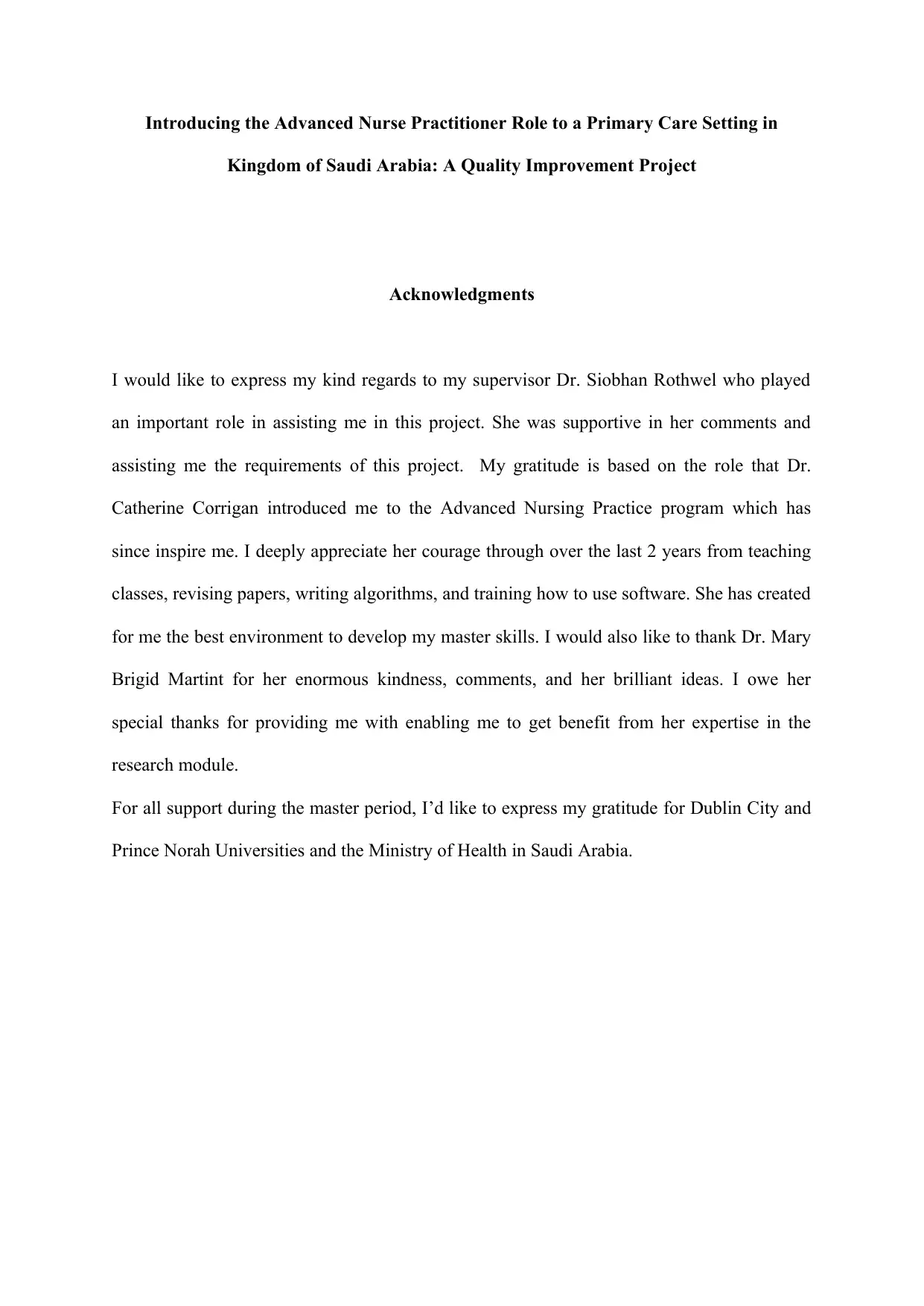
Introducing the Advanced Nurse Practitioner Role to a Primary Care Setting in
Kingdom of Saudi Arabia: A Quality Improvement Project
Acknowledgments
I would like to express my kind regards to my supervisor Dr. Siobhan Rothwel who played
an important role in assisting me in this project. She was supportive in her comments and
assisting me the requirements of this project. My gratitude is based on the role that Dr.
Catherine Corrigan introduced me to the Advanced Nursing Practice program which has
since inspire me. I deeply appreciate her courage through over the last 2 years from teaching
classes, revising papers, writing algorithms, and training how to use software. She has created
for me the best environment to develop my master skills. I would also like to thank Dr. Mary
Brigid Martint for her enormous kindness, comments, and her brilliant ideas. I owe her
special thanks for providing me with enabling me to get benefit from her expertise in the
research module.
For all support during the master period, I’d like to express my gratitude for Dublin City and
Prince Norah Universities and the Ministry of Health in Saudi Arabia.
Kingdom of Saudi Arabia: A Quality Improvement Project
Acknowledgments
I would like to express my kind regards to my supervisor Dr. Siobhan Rothwel who played
an important role in assisting me in this project. She was supportive in her comments and
assisting me the requirements of this project. My gratitude is based on the role that Dr.
Catherine Corrigan introduced me to the Advanced Nursing Practice program which has
since inspire me. I deeply appreciate her courage through over the last 2 years from teaching
classes, revising papers, writing algorithms, and training how to use software. She has created
for me the best environment to develop my master skills. I would also like to thank Dr. Mary
Brigid Martint for her enormous kindness, comments, and her brilliant ideas. I owe her
special thanks for providing me with enabling me to get benefit from her expertise in the
research module.
For all support during the master period, I’d like to express my gratitude for Dublin City and
Prince Norah Universities and the Ministry of Health in Saudi Arabia.
Paraphrase This Document
Need a fresh take? Get an instant paraphrase of this document with our AI Paraphraser

1.0 Introduction
The introduction of the Advanced Nurse Practitioner (ANP) to primary healthcare
settings leads to elevated patient safety, enhanced patient care, and maintain patient medical
care continuity (Kooienga & Carryer, 2015). Previous data reports show that the role of
ANPs is approximately 90% of the primary care services that patients receive which are also
done by other professionals like doctors (Bauer, 2010). Further, it has been reported that
ANPs have higher scores in patient satisfaction, health improvement, illness prevention and
patient acceptance (Newhouse et al., 2011; Grumbach & Grundy, 2010). The patient
expectations on the ANP are based on the need to be accountable as reported in the increased
satisfaction rates among the patients that they serve (Swan et al., 2015; Oliver, 2017). This
comes in handy as the population keeps on increasing and the number of patients that require
care also increases.
The role of ANPs in the current healthcare environment is based on factors like
developing life expectancy and population growth, health-related problems such as diabetes,
and hypertension or bad habits like smoking (Kralewski et al., 2015). The roles of these
professionals have also been extended to other healthcare areas like acute care and
emergency settings meaning that the roles that they play in the primary care are advanced and
include different activities that fall within their clinical jurisdiction (Hibbert, Al-Sanea, and
Balens 2012)
Studies by different scholars have reported the increasing role of these professionals
in clinical settings and how their presence has changed the clinical experience of most
patients. A study by Kralewski et al. (2015) assessed the relationship between the ANPs and
the patient cost level and the care quality in eighty five primary care settings concluded that
ANPs played the leading role in reducing the healthcare costs and leading increased
The introduction of the Advanced Nurse Practitioner (ANP) to primary healthcare
settings leads to elevated patient safety, enhanced patient care, and maintain patient medical
care continuity (Kooienga & Carryer, 2015). Previous data reports show that the role of
ANPs is approximately 90% of the primary care services that patients receive which are also
done by other professionals like doctors (Bauer, 2010). Further, it has been reported that
ANPs have higher scores in patient satisfaction, health improvement, illness prevention and
patient acceptance (Newhouse et al., 2011; Grumbach & Grundy, 2010). The patient
expectations on the ANP are based on the need to be accountable as reported in the increased
satisfaction rates among the patients that they serve (Swan et al., 2015; Oliver, 2017). This
comes in handy as the population keeps on increasing and the number of patients that require
care also increases.
The role of ANPs in the current healthcare environment is based on factors like
developing life expectancy and population growth, health-related problems such as diabetes,
and hypertension or bad habits like smoking (Kralewski et al., 2015). The roles of these
professionals have also been extended to other healthcare areas like acute care and
emergency settings meaning that the roles that they play in the primary care are advanced and
include different activities that fall within their clinical jurisdiction (Hibbert, Al-Sanea, and
Balens 2012)
Studies by different scholars have reported the increasing role of these professionals
in clinical settings and how their presence has changed the clinical experience of most
patients. A study by Kralewski et al. (2015) assessed the relationship between the ANPs and
the patient cost level and the care quality in eighty five primary care settings concluded that
ANPs played the leading role in reducing the healthcare costs and leading increased
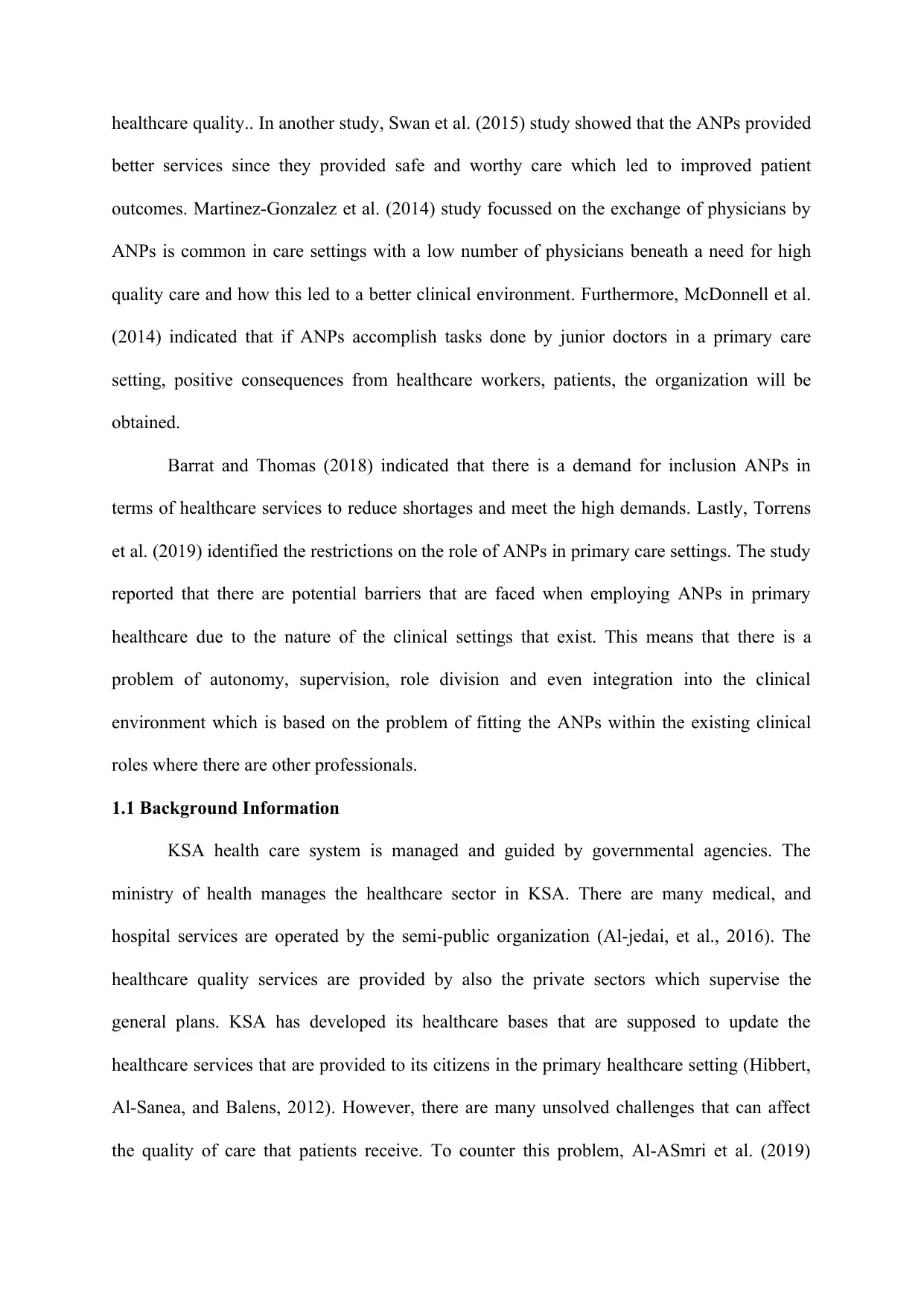
healthcare quality.. In another study, Swan et al. (2015) study showed that the ANPs provided
better services since they provided safe and worthy care which led to improved patient
outcomes. Martinez-Gonzalez et al. (2014) study focussed on the exchange of physicians by
ANPs is common in care settings with a low number of physicians beneath a need for high
quality care and how this led to a better clinical environment. Furthermore, McDonnell et al.
(2014) indicated that if ANPs accomplish tasks done by junior doctors in a primary care
setting, positive consequences from healthcare workers, patients, the organization will be
obtained.
Barrat and Thomas (2018) indicated that there is a demand for inclusion ANPs in
terms of healthcare services to reduce shortages and meet the high demands. Lastly, Torrens
et al. (2019) identified the restrictions on the role of ANPs in primary care settings. The study
reported that there are potential barriers that are faced when employing ANPs in primary
healthcare due to the nature of the clinical settings that exist. This means that there is a
problem of autonomy, supervision, role division and even integration into the clinical
environment which is based on the problem of fitting the ANPs within the existing clinical
roles where there are other professionals.
1.1 Background Information
KSA health care system is managed and guided by governmental agencies. The
ministry of health manages the healthcare sector in KSA. There are many medical, and
hospital services are operated by the semi-public organization (Al-jedai, et al., 2016). The
healthcare quality services are provided by also the private sectors which supervise the
general plans. KSA has developed its healthcare bases that are supposed to update the
healthcare services that are provided to its citizens in the primary healthcare setting (Hibbert,
Al-Sanea, and Balens, 2012). However, there are many unsolved challenges that can affect
the quality of care that patients receive. To counter this problem, Al-ASmri et al. (2019)
better services since they provided safe and worthy care which led to improved patient
outcomes. Martinez-Gonzalez et al. (2014) study focussed on the exchange of physicians by
ANPs is common in care settings with a low number of physicians beneath a need for high
quality care and how this led to a better clinical environment. Furthermore, McDonnell et al.
(2014) indicated that if ANPs accomplish tasks done by junior doctors in a primary care
setting, positive consequences from healthcare workers, patients, the organization will be
obtained.
Barrat and Thomas (2018) indicated that there is a demand for inclusion ANPs in
terms of healthcare services to reduce shortages and meet the high demands. Lastly, Torrens
et al. (2019) identified the restrictions on the role of ANPs in primary care settings. The study
reported that there are potential barriers that are faced when employing ANPs in primary
healthcare due to the nature of the clinical settings that exist. This means that there is a
problem of autonomy, supervision, role division and even integration into the clinical
environment which is based on the problem of fitting the ANPs within the existing clinical
roles where there are other professionals.
1.1 Background Information
KSA health care system is managed and guided by governmental agencies. The
ministry of health manages the healthcare sector in KSA. There are many medical, and
hospital services are operated by the semi-public organization (Al-jedai, et al., 2016). The
healthcare quality services are provided by also the private sectors which supervise the
general plans. KSA has developed its healthcare bases that are supposed to update the
healthcare services that are provided to its citizens in the primary healthcare setting (Hibbert,
Al-Sanea, and Balens, 2012). However, there are many unsolved challenges that can affect
the quality of care that patients receive. To counter this problem, Al-ASmri et al. (2019)
⊘ This is a preview!⊘
Do you want full access?
Subscribe today to unlock all pages.

Trusted by 1+ million students worldwide
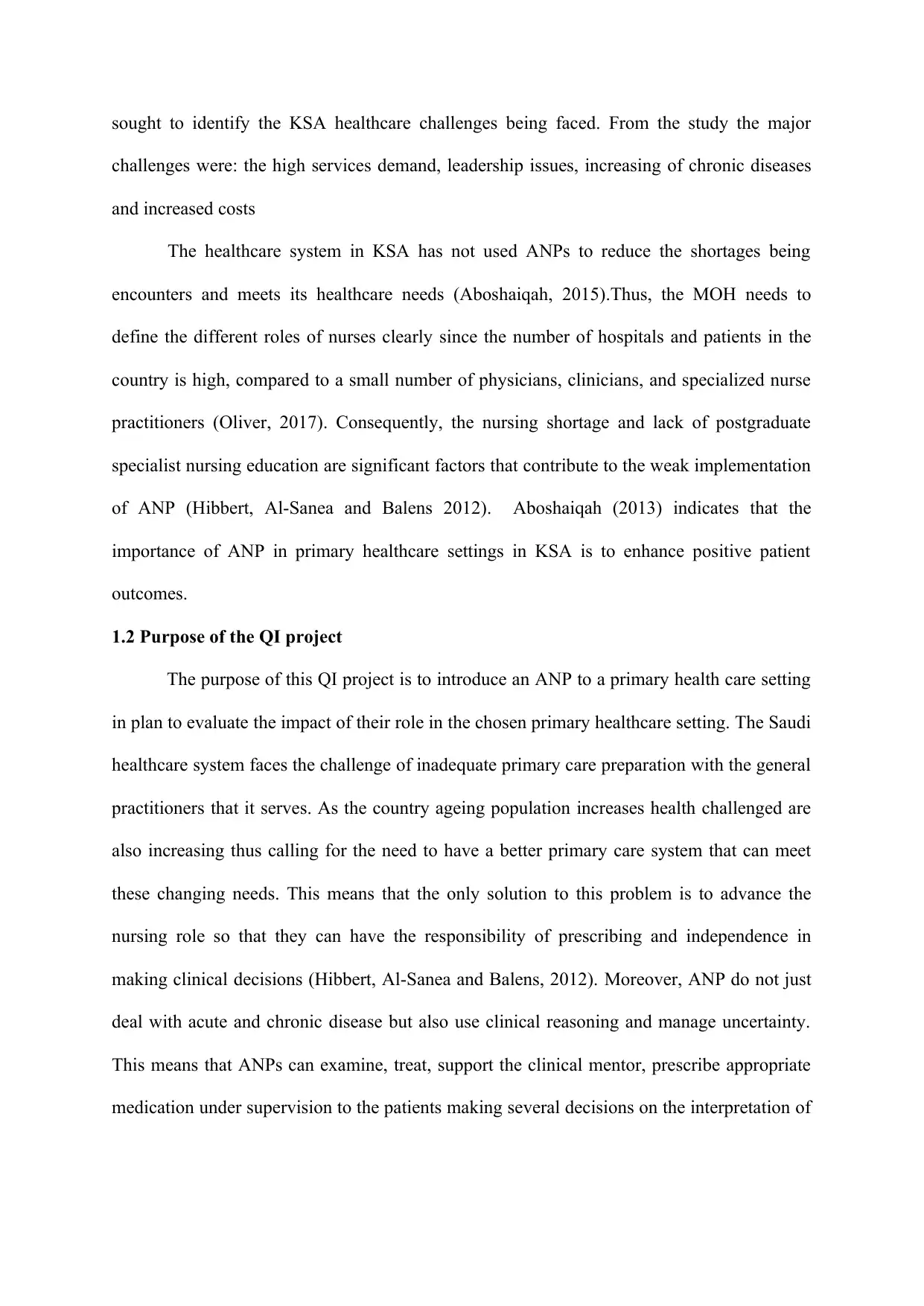
sought to identify the KSA healthcare challenges being faced. From the study the major
challenges were: the high services demand, leadership issues, increasing of chronic diseases
and increased costs
The healthcare system in KSA has not used ANPs to reduce the shortages being
encounters and meets its healthcare needs (Aboshaiqah, 2015).Thus, the MOH needs to
define the different roles of nurses clearly since the number of hospitals and patients in the
country is high, compared to a small number of physicians, clinicians, and specialized nurse
practitioners (Oliver, 2017). Consequently, the nursing shortage and lack of postgraduate
specialist nursing education are significant factors that contribute to the weak implementation
of ANP (Hibbert, Al-Sanea and Balens 2012). Aboshaiqah (2013) indicates that the
importance of ANP in primary healthcare settings in KSA is to enhance positive patient
outcomes.
1.2 Purpose of the QI project
The purpose of this QI project is to introduce an ANP to a primary health care setting
in plan to evaluate the impact of their role in the chosen primary healthcare setting. The Saudi
healthcare system faces the challenge of inadequate primary care preparation with the general
practitioners that it serves. As the country ageing population increases health challenged are
also increasing thus calling for the need to have a better primary care system that can meet
these changing needs. This means that the only solution to this problem is to advance the
nursing role so that they can have the responsibility of prescribing and independence in
making clinical decisions (Hibbert, Al-Sanea and Balens, 2012). Moreover, ANP do not just
deal with acute and chronic disease but also use clinical reasoning and manage uncertainty.
This means that ANPs can examine, treat, support the clinical mentor, prescribe appropriate
medication under supervision to the patients making several decisions on the interpretation of
challenges were: the high services demand, leadership issues, increasing of chronic diseases
and increased costs
The healthcare system in KSA has not used ANPs to reduce the shortages being
encounters and meets its healthcare needs (Aboshaiqah, 2015).Thus, the MOH needs to
define the different roles of nurses clearly since the number of hospitals and patients in the
country is high, compared to a small number of physicians, clinicians, and specialized nurse
practitioners (Oliver, 2017). Consequently, the nursing shortage and lack of postgraduate
specialist nursing education are significant factors that contribute to the weak implementation
of ANP (Hibbert, Al-Sanea and Balens 2012). Aboshaiqah (2013) indicates that the
importance of ANP in primary healthcare settings in KSA is to enhance positive patient
outcomes.
1.2 Purpose of the QI project
The purpose of this QI project is to introduce an ANP to a primary health care setting
in plan to evaluate the impact of their role in the chosen primary healthcare setting. The Saudi
healthcare system faces the challenge of inadequate primary care preparation with the general
practitioners that it serves. As the country ageing population increases health challenged are
also increasing thus calling for the need to have a better primary care system that can meet
these changing needs. This means that the only solution to this problem is to advance the
nursing role so that they can have the responsibility of prescribing and independence in
making clinical decisions (Hibbert, Al-Sanea and Balens, 2012). Moreover, ANP do not just
deal with acute and chronic disease but also use clinical reasoning and manage uncertainty.
This means that ANPs can examine, treat, support the clinical mentor, prescribe appropriate
medication under supervision to the patients making several decisions on the interpretation of
Paraphrase This Document
Need a fresh take? Get an instant paraphrase of this document with our AI Paraphraser
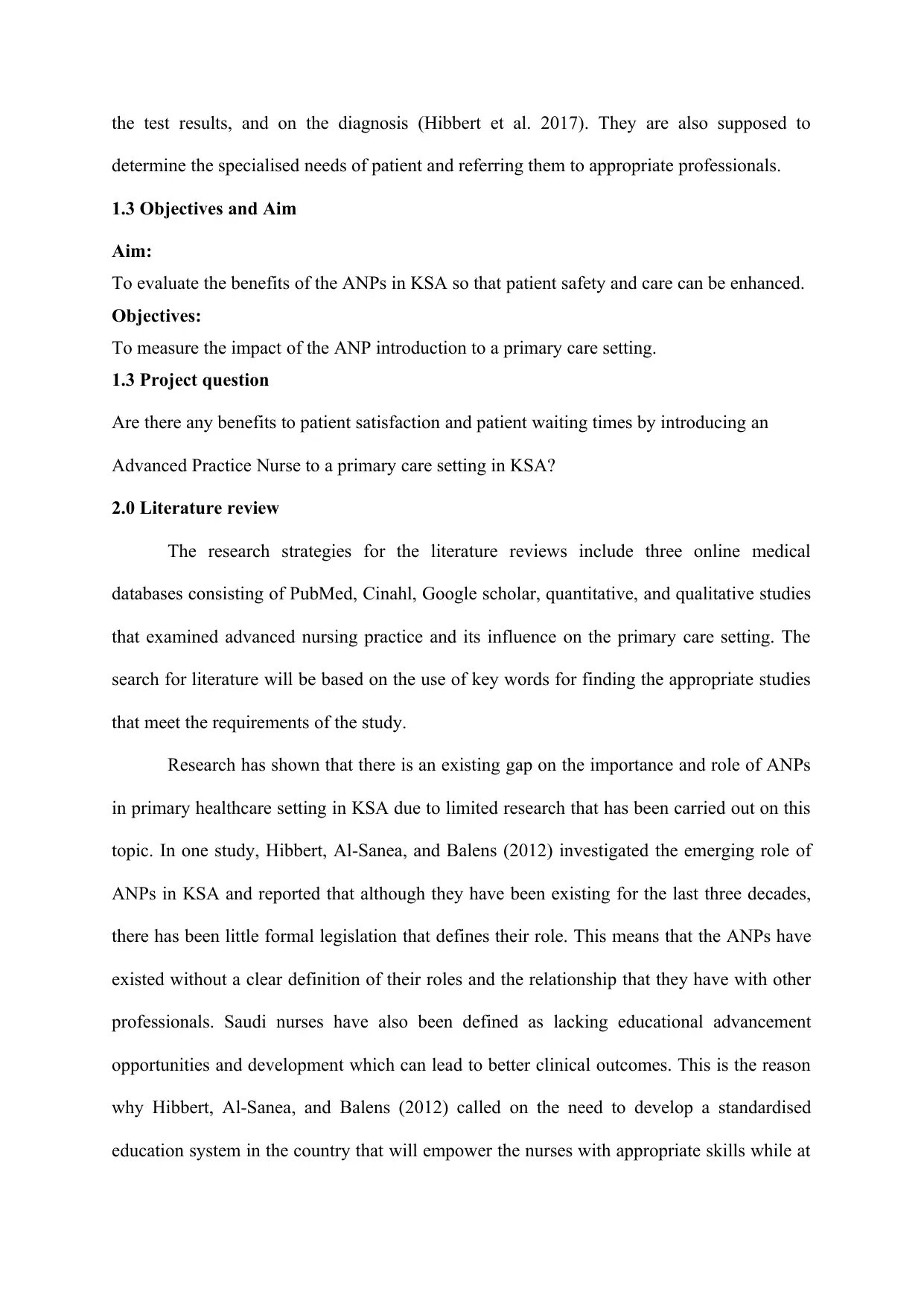
the test results, and on the diagnosis (Hibbert et al. 2017). They are also supposed to
determine the specialised needs of patient and referring them to appropriate professionals.
1.3 Objectives and Aim
Aim:
To evaluate the benefits of the ANPs in KSA so that patient safety and care can be enhanced.
Objectives:
To measure the impact of the ANP introduction to a primary care setting.
1.3 Project question
Are there any benefits to patient satisfaction and patient waiting times by introducing an
Advanced Practice Nurse to a primary care setting in KSA?
2.0 Literature review
The research strategies for the literature reviews include three online medical
databases consisting of PubMed, Cinahl, Google scholar, quantitative, and qualitative studies
that examined advanced nursing practice and its influence on the primary care setting. The
search for literature will be based on the use of key words for finding the appropriate studies
that meet the requirements of the study.
Research has shown that there is an existing gap on the importance and role of ANPs
in primary healthcare setting in KSA due to limited research that has been carried out on this
topic. In one study, Hibbert, Al-Sanea, and Balens (2012) investigated the emerging role of
ANPs in KSA and reported that although they have been existing for the last three decades,
there has been little formal legislation that defines their role. This means that the ANPs have
existed without a clear definition of their roles and the relationship that they have with other
professionals. Saudi nurses have also been defined as lacking educational advancement
opportunities and development which can lead to better clinical outcomes. This is the reason
why Hibbert, Al-Sanea, and Balens (2012) called on the need to develop a standardised
education system in the country that will empower the nurses with appropriate skills while at
determine the specialised needs of patient and referring them to appropriate professionals.
1.3 Objectives and Aim
Aim:
To evaluate the benefits of the ANPs in KSA so that patient safety and care can be enhanced.
Objectives:
To measure the impact of the ANP introduction to a primary care setting.
1.3 Project question
Are there any benefits to patient satisfaction and patient waiting times by introducing an
Advanced Practice Nurse to a primary care setting in KSA?
2.0 Literature review
The research strategies for the literature reviews include three online medical
databases consisting of PubMed, Cinahl, Google scholar, quantitative, and qualitative studies
that examined advanced nursing practice and its influence on the primary care setting. The
search for literature will be based on the use of key words for finding the appropriate studies
that meet the requirements of the study.
Research has shown that there is an existing gap on the importance and role of ANPs
in primary healthcare setting in KSA due to limited research that has been carried out on this
topic. In one study, Hibbert, Al-Sanea, and Balens (2012) investigated the emerging role of
ANPs in KSA and reported that although they have been existing for the last three decades,
there has been little formal legislation that defines their role. This means that the ANPs have
existed without a clear definition of their roles and the relationship that they have with other
professionals. Saudi nurses have also been defined as lacking educational advancement
opportunities and development which can lead to better clinical outcomes. This is the reason
why Hibbert, Al-Sanea, and Balens (2012) called on the need to develop a standardised
education system in the country that will empower the nurses with appropriate skills while at

the same time developing regulations that define the roles that ANPs can play in clinical
settings. This means that by improving the nursing college education in Saudi Arabia, the
country can have a better nursing experience for its population.
The limited research on the role of ANPs has created difficulties in identifying the
challenges that exist in the field and the best way to improve the ANP practices in healthcare.
This creates a heathcare research gap in Saudi Arabia due to the limited information that
exists on the topic. Despite that, similar studies in other countries have highlighted the
challenges that ANPs face in dealing with healthcare problems. Carnwell and Daly (2003)
reported that despite the fact that there is an increasing call on the use of ANPs in clinical
settings, there are management and support problem that the professionals experience due to
the nature of the primary care setting that they operate in. Ljungbeck and Sjögren Forss
(2017) study added that Swedish healthcare professional opinion on ANPs showed that the
speciality experience of these professionals is limited since they are not adequately utilised
due to lack of regulations. The fact that nurse leaders and managers are not fully aware of this
new role makes it difficult for them to integrate it within the clinical settings. Jenkins,
Docherty, and Cain (2018) recommended that this challenge can be addressed through the
development of practice areas through support, improving patient experience and promoting
change within the clinical environment so that ANPs can be allowed to practice adequately.
Furthermore, results by Bergman et al. (2013) show that the limited support of the
ANPs by management is a major factor that contributes to high attrition rates and poor
retention of ANPs who prefer alternative healthcare roles. Anderson, Adamson, and Birks
(2018) study reported the challenge of unlimited preparation that most stakehlders who are
supposed to support the ANPs have. The study by Anderson, Adamson, and Birks (2018)
investigated how to practice websites present GPs, PNs, and ANPs to patients and the
implication of creating awareness about available consulting options. Results from 79 sites
settings. This means that by improving the nursing college education in Saudi Arabia, the
country can have a better nursing experience for its population.
The limited research on the role of ANPs has created difficulties in identifying the
challenges that exist in the field and the best way to improve the ANP practices in healthcare.
This creates a heathcare research gap in Saudi Arabia due to the limited information that
exists on the topic. Despite that, similar studies in other countries have highlighted the
challenges that ANPs face in dealing with healthcare problems. Carnwell and Daly (2003)
reported that despite the fact that there is an increasing call on the use of ANPs in clinical
settings, there are management and support problem that the professionals experience due to
the nature of the primary care setting that they operate in. Ljungbeck and Sjögren Forss
(2017) study added that Swedish healthcare professional opinion on ANPs showed that the
speciality experience of these professionals is limited since they are not adequately utilised
due to lack of regulations. The fact that nurse leaders and managers are not fully aware of this
new role makes it difficult for them to integrate it within the clinical settings. Jenkins,
Docherty, and Cain (2018) recommended that this challenge can be addressed through the
development of practice areas through support, improving patient experience and promoting
change within the clinical environment so that ANPs can be allowed to practice adequately.
Furthermore, results by Bergman et al. (2013) show that the limited support of the
ANPs by management is a major factor that contributes to high attrition rates and poor
retention of ANPs who prefer alternative healthcare roles. Anderson, Adamson, and Birks
(2018) study reported the challenge of unlimited preparation that most stakehlders who are
supposed to support the ANPs have. The study by Anderson, Adamson, and Birks (2018)
investigated how to practice websites present GPs, PNs, and ANPs to patients and the
implication of creating awareness about available consulting options. Results from 79 sites
⊘ This is a preview!⊘
Do you want full access?
Subscribe today to unlock all pages.

Trusted by 1+ million students worldwide
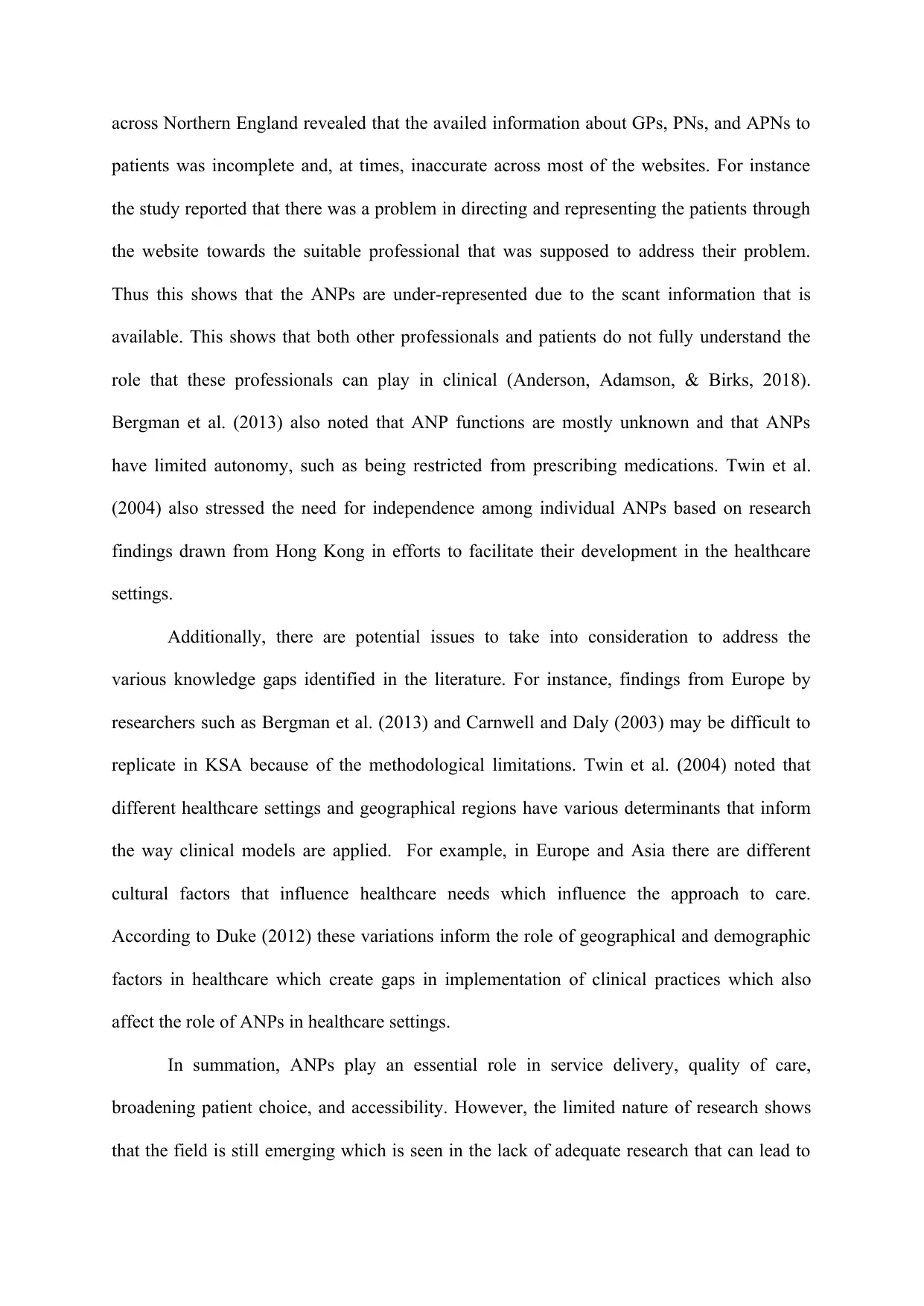
across Northern England revealed that the availed information about GPs, PNs, and APNs to
patients was incomplete and, at times, inaccurate across most of the websites. For instance
the study reported that there was a problem in directing and representing the patients through
the website towards the suitable professional that was supposed to address their problem.
Thus this shows that the ANPs are under-represented due to the scant information that is
available. This shows that both other professionals and patients do not fully understand the
role that these professionals can play in clinical (Anderson, Adamson, & Birks, 2018).
Bergman et al. (2013) also noted that ANP functions are mostly unknown and that ANPs
have limited autonomy, such as being restricted from prescribing medications. Twin et al.
(2004) also stressed the need for independence among individual ANPs based on research
findings drawn from Hong Kong in efforts to facilitate their development in the healthcare
settings.
Additionally, there are potential issues to take into consideration to address the
various knowledge gaps identified in the literature. For instance, findings from Europe by
researchers such as Bergman et al. (2013) and Carnwell and Daly (2003) may be difficult to
replicate in KSA because of the methodological limitations. Twin et al. (2004) noted that
different healthcare settings and geographical regions have various determinants that inform
the way clinical models are applied. For example, in Europe and Asia there are different
cultural factors that influence healthcare needs which influence the approach to care.
According to Duke (2012) these variations inform the role of geographical and demographic
factors in healthcare which create gaps in implementation of clinical practices which also
affect the role of ANPs in healthcare settings.
In summation, ANPs play an essential role in service delivery, quality of care,
broadening patient choice, and accessibility. However, the limited nature of research shows
that the field is still emerging which is seen in the lack of adequate research that can lead to
patients was incomplete and, at times, inaccurate across most of the websites. For instance
the study reported that there was a problem in directing and representing the patients through
the website towards the suitable professional that was supposed to address their problem.
Thus this shows that the ANPs are under-represented due to the scant information that is
available. This shows that both other professionals and patients do not fully understand the
role that these professionals can play in clinical (Anderson, Adamson, & Birks, 2018).
Bergman et al. (2013) also noted that ANP functions are mostly unknown and that ANPs
have limited autonomy, such as being restricted from prescribing medications. Twin et al.
(2004) also stressed the need for independence among individual ANPs based on research
findings drawn from Hong Kong in efforts to facilitate their development in the healthcare
settings.
Additionally, there are potential issues to take into consideration to address the
various knowledge gaps identified in the literature. For instance, findings from Europe by
researchers such as Bergman et al. (2013) and Carnwell and Daly (2003) may be difficult to
replicate in KSA because of the methodological limitations. Twin et al. (2004) noted that
different healthcare settings and geographical regions have various determinants that inform
the way clinical models are applied. For example, in Europe and Asia there are different
cultural factors that influence healthcare needs which influence the approach to care.
According to Duke (2012) these variations inform the role of geographical and demographic
factors in healthcare which create gaps in implementation of clinical practices which also
affect the role of ANPs in healthcare settings.
In summation, ANPs play an essential role in service delivery, quality of care,
broadening patient choice, and accessibility. However, the limited nature of research shows
that the field is still emerging which is seen in the lack of adequate research that can lead to
Paraphrase This Document
Need a fresh take? Get an instant paraphrase of this document with our AI Paraphraser
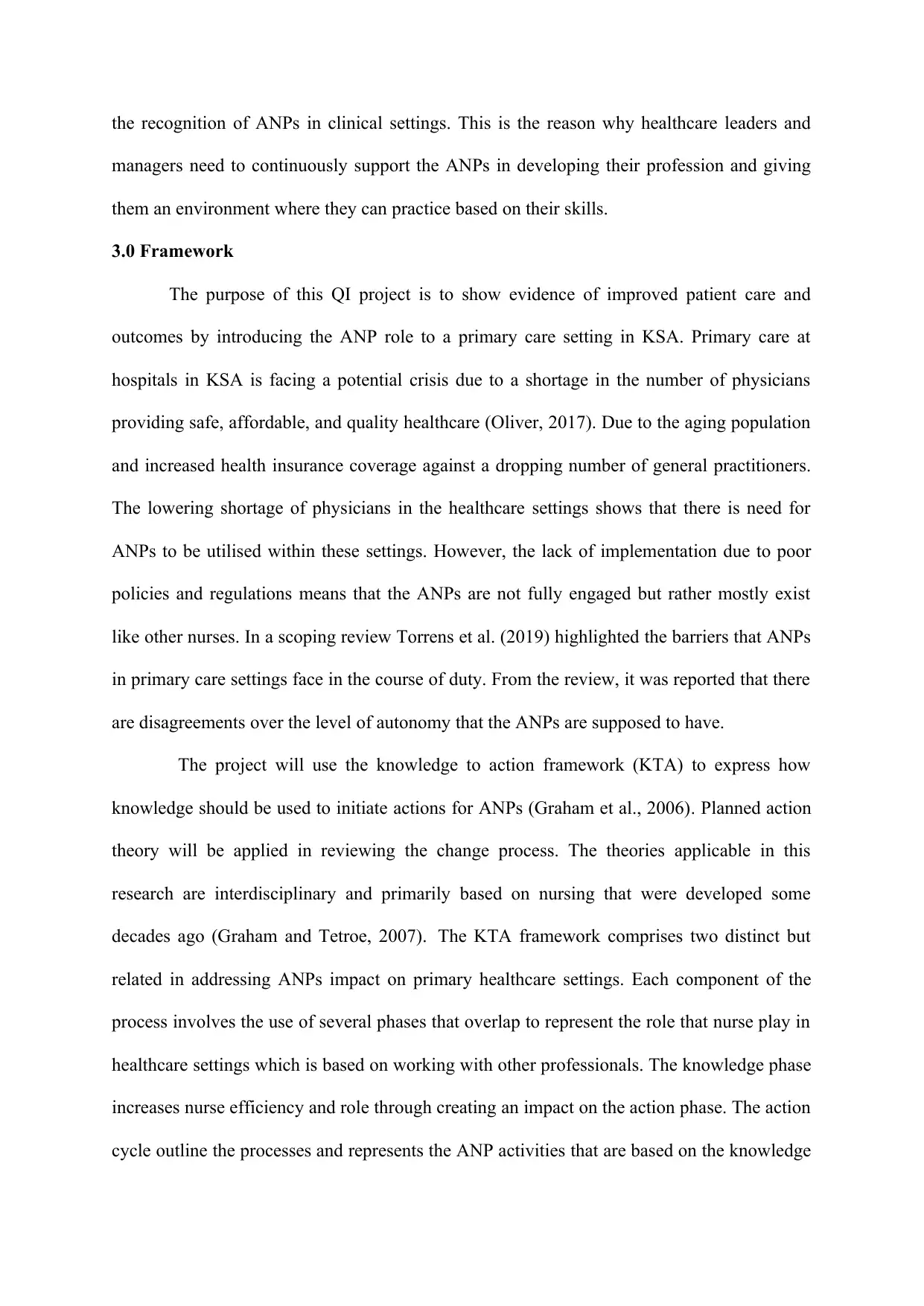
the recognition of ANPs in clinical settings. This is the reason why healthcare leaders and
managers need to continuously support the ANPs in developing their profession and giving
them an environment where they can practice based on their skills.
3.0 Framework
The purpose of this QI project is to show evidence of improved patient care and
outcomes by introducing the ANP role to a primary care setting in KSA. Primary care at
hospitals in KSA is facing a potential crisis due to a shortage in the number of physicians
providing safe, affordable, and quality healthcare (Oliver, 2017). Due to the aging population
and increased health insurance coverage against a dropping number of general practitioners.
The lowering shortage of physicians in the healthcare settings shows that there is need for
ANPs to be utilised within these settings. However, the lack of implementation due to poor
policies and regulations means that the ANPs are not fully engaged but rather mostly exist
like other nurses. In a scoping review Torrens et al. (2019) highlighted the barriers that ANPs
in primary care settings face in the course of duty. From the review, it was reported that there
are disagreements over the level of autonomy that the ANPs are supposed to have.
The project will use the knowledge to action framework (KTA) to express how
knowledge should be used to initiate actions for ANPs (Graham et al., 2006). Planned action
theory will be applied in reviewing the change process. The theories applicable in this
research are interdisciplinary and primarily based on nursing that were developed some
decades ago (Graham and Tetroe, 2007). The KTA framework comprises two distinct but
related in addressing ANPs impact on primary healthcare settings. Each component of the
process involves the use of several phases that overlap to represent the role that nurse play in
healthcare settings which is based on working with other professionals. The knowledge phase
increases nurse efficiency and role through creating an impact on the action phase. The action
cycle outline the processes and represents the ANP activities that are based on the knowledge
managers need to continuously support the ANPs in developing their profession and giving
them an environment where they can practice based on their skills.
3.0 Framework
The purpose of this QI project is to show evidence of improved patient care and
outcomes by introducing the ANP role to a primary care setting in KSA. Primary care at
hospitals in KSA is facing a potential crisis due to a shortage in the number of physicians
providing safe, affordable, and quality healthcare (Oliver, 2017). Due to the aging population
and increased health insurance coverage against a dropping number of general practitioners.
The lowering shortage of physicians in the healthcare settings shows that there is need for
ANPs to be utilised within these settings. However, the lack of implementation due to poor
policies and regulations means that the ANPs are not fully engaged but rather mostly exist
like other nurses. In a scoping review Torrens et al. (2019) highlighted the barriers that ANPs
in primary care settings face in the course of duty. From the review, it was reported that there
are disagreements over the level of autonomy that the ANPs are supposed to have.
The project will use the knowledge to action framework (KTA) to express how
knowledge should be used to initiate actions for ANPs (Graham et al., 2006). Planned action
theory will be applied in reviewing the change process. The theories applicable in this
research are interdisciplinary and primarily based on nursing that were developed some
decades ago (Graham and Tetroe, 2007). The KTA framework comprises two distinct but
related in addressing ANPs impact on primary healthcare settings. Each component of the
process involves the use of several phases that overlap to represent the role that nurse play in
healthcare settings which is based on working with other professionals. The knowledge phase
increases nurse efficiency and role through creating an impact on the action phase. The action
cycle outline the processes and represents the ANP activities that are based on the knowledge
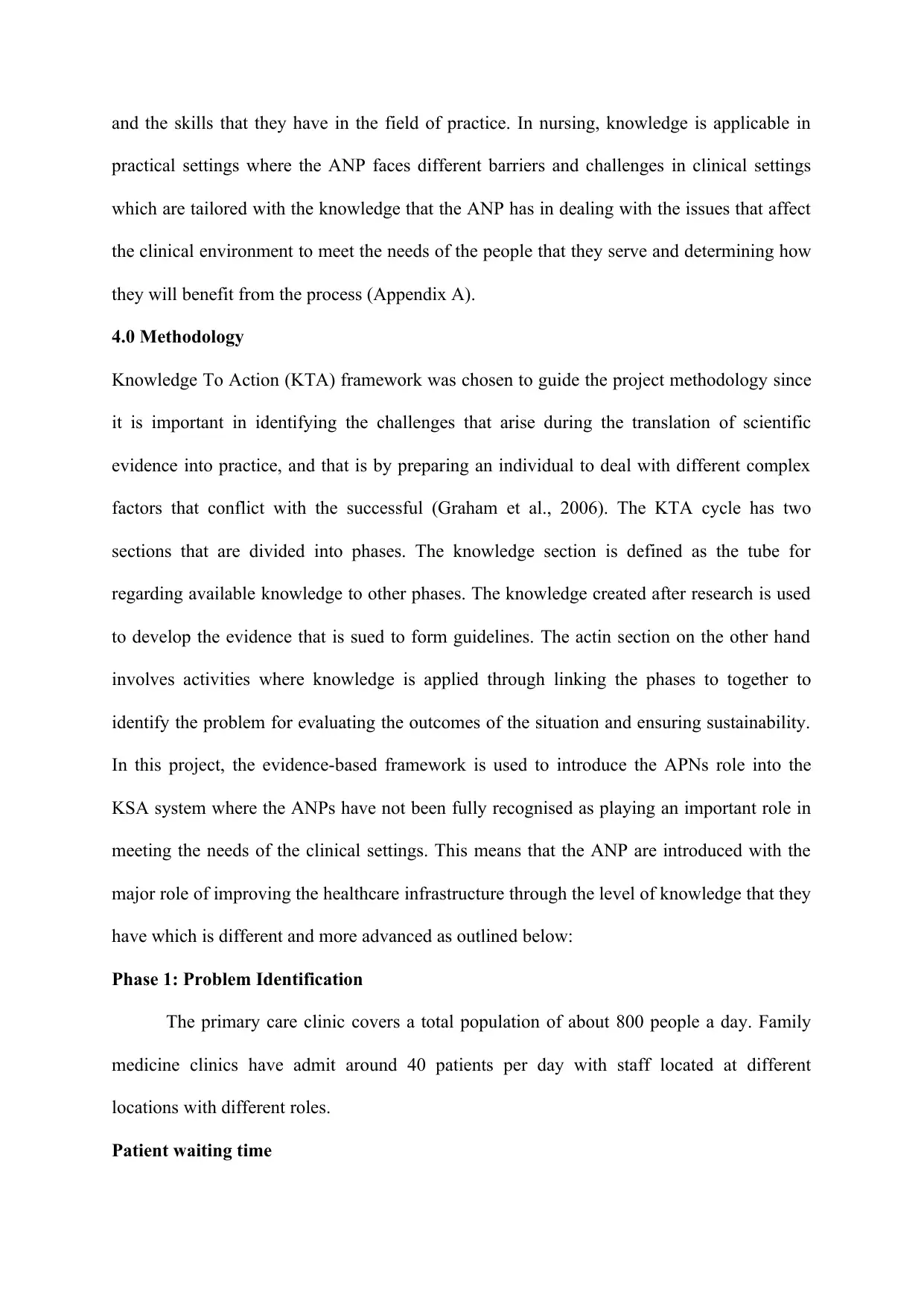
and the skills that they have in the field of practice. In nursing, knowledge is applicable in
practical settings where the ANP faces different barriers and challenges in clinical settings
which are tailored with the knowledge that the ANP has in dealing with the issues that affect
the clinical environment to meet the needs of the people that they serve and determining how
they will benefit from the process (Appendix A).
4.0 Methodology
Knowledge To Action (KTA) framework was chosen to guide the project methodology since
it is important in identifying the challenges that arise during the translation of scientific
evidence into practice, and that is by preparing an individual to deal with different complex
factors that conflict with the successful (Graham et al., 2006). The KTA cycle has two
sections that are divided into phases. The knowledge section is defined as the tube for
regarding available knowledge to other phases. The knowledge created after research is used
to develop the evidence that is sued to form guidelines. The actin section on the other hand
involves activities where knowledge is applied through linking the phases to together to
identify the problem for evaluating the outcomes of the situation and ensuring sustainability.
In this project, the evidence-based framework is used to introduce the APNs role into the
KSA system where the ANPs have not been fully recognised as playing an important role in
meeting the needs of the clinical settings. This means that the ANP are introduced with the
major role of improving the healthcare infrastructure through the level of knowledge that they
have which is different and more advanced as outlined below:
Phase 1: Problem Identification
The primary care clinic covers a total population of about 800 people a day. Family
medicine clinics have admit around 40 patients per day with staff located at different
locations with different roles.
Patient waiting time
practical settings where the ANP faces different barriers and challenges in clinical settings
which are tailored with the knowledge that the ANP has in dealing with the issues that affect
the clinical environment to meet the needs of the people that they serve and determining how
they will benefit from the process (Appendix A).
4.0 Methodology
Knowledge To Action (KTA) framework was chosen to guide the project methodology since
it is important in identifying the challenges that arise during the translation of scientific
evidence into practice, and that is by preparing an individual to deal with different complex
factors that conflict with the successful (Graham et al., 2006). The KTA cycle has two
sections that are divided into phases. The knowledge section is defined as the tube for
regarding available knowledge to other phases. The knowledge created after research is used
to develop the evidence that is sued to form guidelines. The actin section on the other hand
involves activities where knowledge is applied through linking the phases to together to
identify the problem for evaluating the outcomes of the situation and ensuring sustainability.
In this project, the evidence-based framework is used to introduce the APNs role into the
KSA system where the ANPs have not been fully recognised as playing an important role in
meeting the needs of the clinical settings. This means that the ANP are introduced with the
major role of improving the healthcare infrastructure through the level of knowledge that they
have which is different and more advanced as outlined below:
Phase 1: Problem Identification
The primary care clinic covers a total population of about 800 people a day. Family
medicine clinics have admit around 40 patients per day with staff located at different
locations with different roles.
Patient waiting time
⊘ This is a preview!⊘
Do you want full access?
Subscribe today to unlock all pages.

Trusted by 1+ million students worldwide
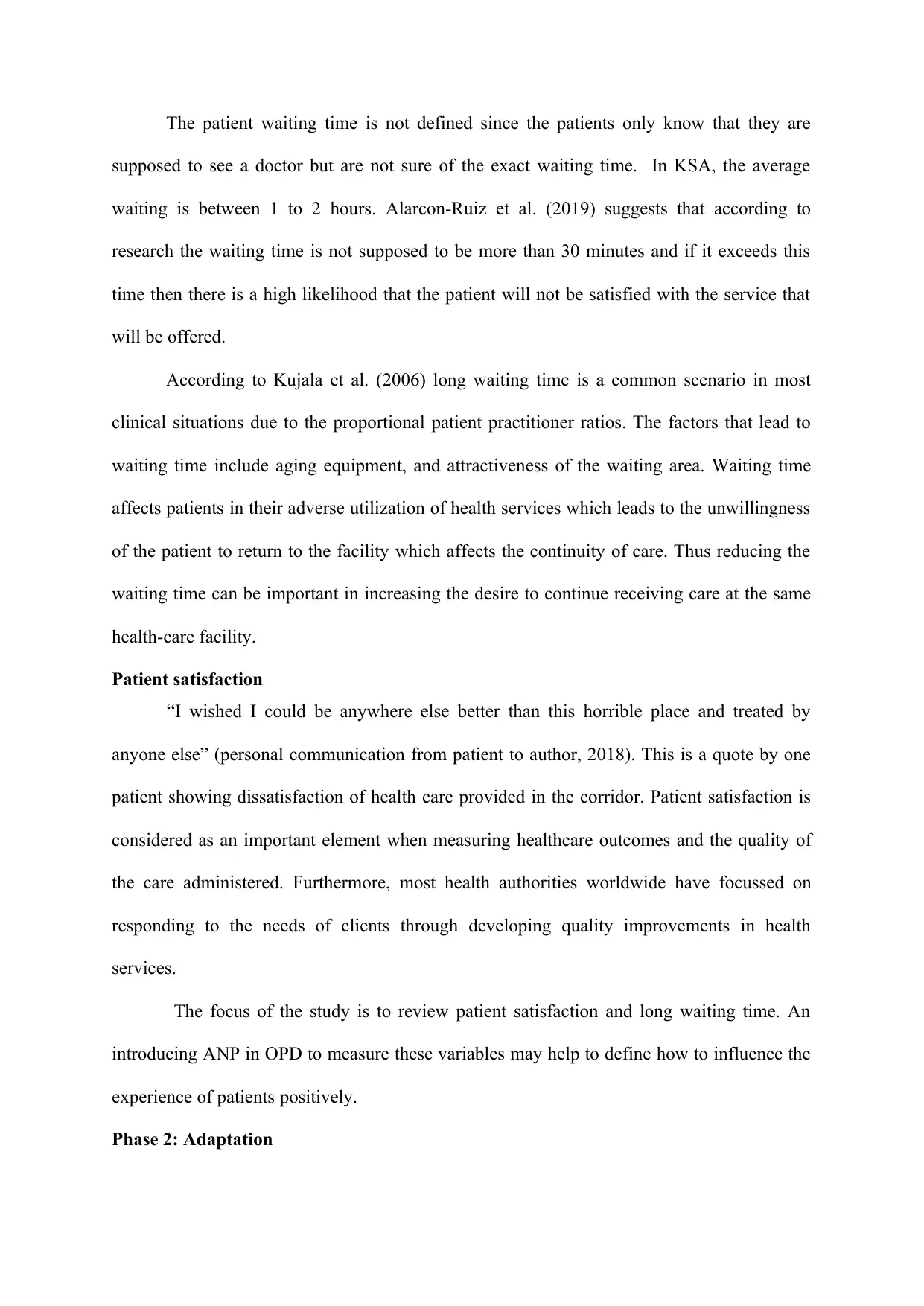
The patient waiting time is not defined since the patients only know that they are
supposed to see a doctor but are not sure of the exact waiting time. In KSA, the average
waiting is between 1 to 2 hours. Alarcon-Ruiz et al. (2019) suggests that according to
research the waiting time is not supposed to be more than 30 minutes and if it exceeds this
time then there is a high likelihood that the patient will not be satisfied with the service that
will be offered.
According to Kujala et al. (2006) long waiting time is a common scenario in most
clinical situations due to the proportional patient practitioner ratios. The factors that lead to
waiting time include aging equipment, and attractiveness of the waiting area. Waiting time
affects patients in their adverse utilization of health services which leads to the unwillingness
of the patient to return to the facility which affects the continuity of care. Thus reducing the
waiting time can be important in increasing the desire to continue receiving care at the same
health-care facility.
Patient satisfaction
“I wished I could be anywhere else better than this horrible place and treated by
anyone else” (personal communication from patient to author, 2018). This is a quote by one
patient showing dissatisfaction of health care provided in the corridor. Patient satisfaction is
considered as an important element when measuring healthcare outcomes and the quality of
the care administered. Furthermore, most health authorities worldwide have focussed on
responding to the needs of clients through developing quality improvements in health
services.
The focus of the study is to review patient satisfaction and long waiting time. An
introducing ANP in OPD to measure these variables may help to define how to influence the
experience of patients positively.
Phase 2: Adaptation
supposed to see a doctor but are not sure of the exact waiting time. In KSA, the average
waiting is between 1 to 2 hours. Alarcon-Ruiz et al. (2019) suggests that according to
research the waiting time is not supposed to be more than 30 minutes and if it exceeds this
time then there is a high likelihood that the patient will not be satisfied with the service that
will be offered.
According to Kujala et al. (2006) long waiting time is a common scenario in most
clinical situations due to the proportional patient practitioner ratios. The factors that lead to
waiting time include aging equipment, and attractiveness of the waiting area. Waiting time
affects patients in their adverse utilization of health services which leads to the unwillingness
of the patient to return to the facility which affects the continuity of care. Thus reducing the
waiting time can be important in increasing the desire to continue receiving care at the same
health-care facility.
Patient satisfaction
“I wished I could be anywhere else better than this horrible place and treated by
anyone else” (personal communication from patient to author, 2018). This is a quote by one
patient showing dissatisfaction of health care provided in the corridor. Patient satisfaction is
considered as an important element when measuring healthcare outcomes and the quality of
the care administered. Furthermore, most health authorities worldwide have focussed on
responding to the needs of clients through developing quality improvements in health
services.
The focus of the study is to review patient satisfaction and long waiting time. An
introducing ANP in OPD to measure these variables may help to define how to influence the
experience of patients positively.
Phase 2: Adaptation
Paraphrase This Document
Need a fresh take? Get an instant paraphrase of this document with our AI Paraphraser
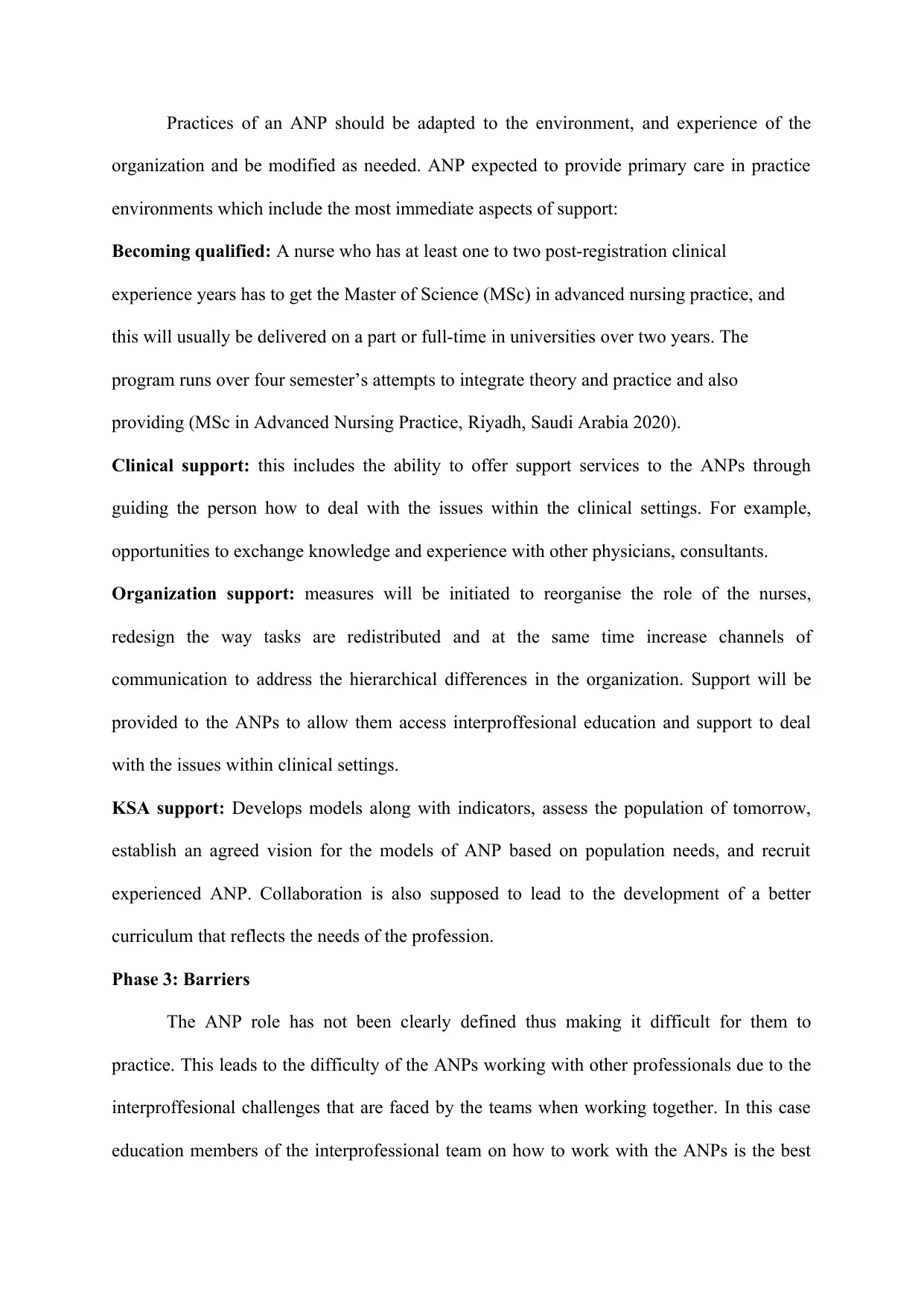
Practices of an ANP should be adapted to the environment, and experience of the
organization and be modified as needed. ANP expected to provide primary care in practice
environments which include the most immediate aspects of support:
Becoming qualified: A nurse who has at least one to two post-registration clinical
experience years has to get the Master of Science (MSc) in advanced nursing practice, and
this will usually be delivered on a part or full-time in universities over two years. The
program runs over four semester’s attempts to integrate theory and practice and also
providing (MSc in Advanced Nursing Practice, Riyadh, Saudi Arabia 2020).
Clinical support: this includes the ability to offer support services to the ANPs through
guiding the person how to deal with the issues within the clinical settings. For example,
opportunities to exchange knowledge and experience with other physicians, consultants.
Organization support: measures will be initiated to reorganise the role of the nurses,
redesign the way tasks are redistributed and at the same time increase channels of
communication to address the hierarchical differences in the organization. Support will be
provided to the ANPs to allow them access interproffesional education and support to deal
with the issues within clinical settings.
KSA support: Develops models along with indicators, assess the population of tomorrow,
establish an agreed vision for the models of ANP based on population needs, and recruit
experienced ANP. Collaboration is also supposed to lead to the development of a better
curriculum that reflects the needs of the profession.
Phase 3: Barriers
The ANP role has not been clearly defined thus making it difficult for them to
practice. This leads to the difficulty of the ANPs working with other professionals due to the
interproffesional challenges that are faced by the teams when working together. In this case
education members of the interprofessional team on how to work with the ANPs is the best
organization and be modified as needed. ANP expected to provide primary care in practice
environments which include the most immediate aspects of support:
Becoming qualified: A nurse who has at least one to two post-registration clinical
experience years has to get the Master of Science (MSc) in advanced nursing practice, and
this will usually be delivered on a part or full-time in universities over two years. The
program runs over four semester’s attempts to integrate theory and practice and also
providing (MSc in Advanced Nursing Practice, Riyadh, Saudi Arabia 2020).
Clinical support: this includes the ability to offer support services to the ANPs through
guiding the person how to deal with the issues within the clinical settings. For example,
opportunities to exchange knowledge and experience with other physicians, consultants.
Organization support: measures will be initiated to reorganise the role of the nurses,
redesign the way tasks are redistributed and at the same time increase channels of
communication to address the hierarchical differences in the organization. Support will be
provided to the ANPs to allow them access interproffesional education and support to deal
with the issues within clinical settings.
KSA support: Develops models along with indicators, assess the population of tomorrow,
establish an agreed vision for the models of ANP based on population needs, and recruit
experienced ANP. Collaboration is also supposed to lead to the development of a better
curriculum that reflects the needs of the profession.
Phase 3: Barriers
The ANP role has not been clearly defined thus making it difficult for them to
practice. This leads to the difficulty of the ANPs working with other professionals due to the
interproffesional challenges that are faced by the teams when working together. In this case
education members of the interprofessional team on how to work with the ANPs is the best

way of ensuring that other professionals and even patients understand the role that these new
clinical professionals play in meeting the healthcare needs. This calls for a plan on how the
roles will be distributed amongst the professional teams with the ANPs on board. The best
way is to empower other professionals with inter-disciplinary skills that will allow the ANPs
to be integrated into the new system Patient acceptance will be the most severe barrier. It
would be a challenge of duties assignments by the fact that patients who have gotten used to
seek services from physicians would be expected to exhibit the same confidence when been
cared for by the ANP. So, It is crucial that patients would be educated on the qualifications,
scope of practice, and the importance of ANP By distributing leaflets and making a TV show
in waiting rooms, then they can be more accepting of receiving care. Moreover, many
obstacles may arise at the start of this project, and the key to manage that conflict is to find
effective facilitators. So, the chief nursing officer (CNO) and the director of the nursing
education department will be the facilitators for this project in order to ensure success in
project delivery. Getting the facilitation will benefit the project in solving potential problems,
increase productivity and efficiency of the team, facilitate training, coaching, workshops,
seminars, consulting, recommendations, overall guidance, and supervision reports.
Phase 4: Implementation
One advanced nurse practitioner will be introduced to a primary health care clinic in
Riyadh in Saudi Arabia. Data will be collected to measure the variables of patient satisfaction
and waiting time through using tools of a questionnaire and measurements of time-in, and
time-out. A nurse who has recently graduated with a Masters of Advanced Nursing Practice
will be invited to be involved in the QI project implementation. In order to be sure that a
work environment enables ANP to perform the best ability and being fulfilled; there are
certain fundamentals which have to be in place as per the following:
clinical professionals play in meeting the healthcare needs. This calls for a plan on how the
roles will be distributed amongst the professional teams with the ANPs on board. The best
way is to empower other professionals with inter-disciplinary skills that will allow the ANPs
to be integrated into the new system Patient acceptance will be the most severe barrier. It
would be a challenge of duties assignments by the fact that patients who have gotten used to
seek services from physicians would be expected to exhibit the same confidence when been
cared for by the ANP. So, It is crucial that patients would be educated on the qualifications,
scope of practice, and the importance of ANP By distributing leaflets and making a TV show
in waiting rooms, then they can be more accepting of receiving care. Moreover, many
obstacles may arise at the start of this project, and the key to manage that conflict is to find
effective facilitators. So, the chief nursing officer (CNO) and the director of the nursing
education department will be the facilitators for this project in order to ensure success in
project delivery. Getting the facilitation will benefit the project in solving potential problems,
increase productivity and efficiency of the team, facilitate training, coaching, workshops,
seminars, consulting, recommendations, overall guidance, and supervision reports.
Phase 4: Implementation
One advanced nurse practitioner will be introduced to a primary health care clinic in
Riyadh in Saudi Arabia. Data will be collected to measure the variables of patient satisfaction
and waiting time through using tools of a questionnaire and measurements of time-in, and
time-out. A nurse who has recently graduated with a Masters of Advanced Nursing Practice
will be invited to be involved in the QI project implementation. In order to be sure that a
work environment enables ANP to perform the best ability and being fulfilled; there are
certain fundamentals which have to be in place as per the following:
⊘ This is a preview!⊘
Do you want full access?
Subscribe today to unlock all pages.

Trusted by 1+ million students worldwide
1 out of 25
Related Documents
Your All-in-One AI-Powered Toolkit for Academic Success.
+13062052269
info@desklib.com
Available 24*7 on WhatsApp / Email
![[object Object]](/_next/static/media/star-bottom.7253800d.svg)
Unlock your academic potential
Copyright © 2020–2025 A2Z Services. All Rights Reserved. Developed and managed by ZUCOL.





